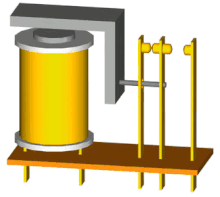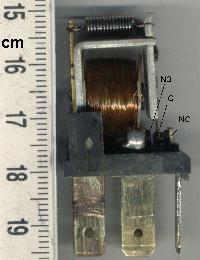Relay
American scientist Joseph Henry is often cited to have invented a relay in 1835 in order to improve his version of the electrical telegraph, developed earlier in 1831.[6][7] In March 1837 Edward Davy deposited a letter with the British Secretary for the Society of Arts containing his ideas for an electromagnetic relay, which, even if it was not the first, was considered more practical than previous designs, being a ‘make-and-break’ type rather than being based on the use of mercury.When the coil is energized with direct current, a flyback diode or snubber resistor is often placed across the coil to dissipate the energy from the collapsing magnetic field (back EMF) at deactivation, which would otherwise generate a voltage spike dangerous to semiconductor circuit components.Typically this is done with a small copper "shading ring" crimped around a portion of the core that creates the delayed, out-of-phase component,[13] which holds the contacts during the zero crossings of the control voltage.Materials with low contact resistance may be oxidized by the air, or may tend to "stick" instead of cleanly parting when opening.The relay contacts are designed not to reflect any radio frequency power back toward the source, and to provide very high isolation between receiver and transmitter terminals.[20] A contactor is a heavy-duty relay with higher current ratings,[21] used for switching electric motors and lighting loads.A latching relay allows remote control of building lighting without the hum that may be produced from a continuously (AC) energized coil.[24] This type may be found in certain cars, for headlamp dipping and other functions where alternating operation on each switch actuation is needed.[clarification needed] Very early computers often stored bits in a magnetically latching relay, such as ferreed or the later remreed in the 1ESS switch.For high-speed applications, the mercury eliminates contact bounce, and provides virtually instantaneous circuit closure.[27] The other common overload protection system uses an electromagnet coil in series with the motor circuit that directly operates contacts.To prevent short over current spikes from causing nuisance triggering the armature movement is damped with a dashpot.Some motor protection relays include temperature detector inputs for direct measurement from a thermocouple or resistance thermometer sensor embedded in the winding.Polarized relays were used in middle 20th Century telephone exchanges to detect faint pulses and correct telegraphic distortion.In the event of a hazard, the task of such a safety function is to use appropriate measures to reduce the existing risk to an acceptable level.Some relays are constructed with a kind of "shock absorber" mechanism attached to the armature, which prevents immediate, full motion when the coil is either energized or de-energized.Because the delay occurs in the direction of coil energization, this type of contact is alternatively known as a normally open, on-delay.In an automobile, a starter relay allows the high current of the cranking motor to be controlled with small wiring and contacts in the ignition key.Electromechanical switching systems including Strowger and crossbar telephone exchanges made extensive use of relays in ancillary control circuits.The first public relay based telephone exchange in the UK was installed in Fleetwood on 15 July 1922 and remained in service until 1959.Relays are much more resistant than semiconductors to nuclear radiation, so they are widely used in safety-critical logic, such as the control panels of radioactive waste-handling machinery.Electromechanical protective relays are used to detect overload and other faults on electrical lines by opening and closing circuit breakers.For protection of electrical apparatus and transmission lines, electromechanical relays with accurate operating characteristics were used to detect overload, short-circuits, and other faults.Contacts are widely spaced to prevent flashovers and short circuits over a lifetime that may exceed fifty years.Since rail signal circuits must be highly reliable, special techniques are used to detect and prevent failures in the relay system.When the circuit is broken, the current cannot change instantaneously, which creates a potentially damaging arc across the separating contacts.In many situations, the break arc is more energetic and thus more destructive, in particular with inductive loads, but this can be mitigated by bridging the contacts with a snubber circuit.The extremely high temperature of the arc splits the surrounding gas molecules, creating ozone, carbon monoxide, and other compounds.Over time, the arc energy slowly destroys the contact metal, causing some material to escape into the air as fine particulate matter.
















Relay (disambiguation)electricallyswitchtelegraphtelephone exchangeselectromechanicalelectromagnetsolid-state relayssemiconductormoving partsprotective relayssafety relaysSamuel Thomas von SömmerringtelegraphsJoseph Henryelectrical telegraphEdward DavyCharles WheatstoneWilliam CookeSamuel Morseflyback diodesoft iron corereluctancearmaturespringprinted circuit boardelectric currentmagnetic fielddirect currentsnubberresistorback EMFvoltage spiketransistorsreactivealternating currentswitchescontactsForm AForm BForm CForm DForm EactuatorDIN 72552transceiverscharacteristic impedancetransmission linecontactorelectric motorssilversilver oxideavionicsremanentH-bridgeheadlampstepping relayearth-leakage circuit breakerferreedremreed1ESS switchsequential circuit(self-)holding circuitsdelay-line memorymachine toolsform factorprogrammable logic controllerrelay logicladder logicprogrammable logic controllersmercury relaymercury switchmercurycoalesceinductanceovercurrentbimetallic stripdashpotthermocoupleresistance thermometerreed relayreed switchevacuatedinert gascorrosionmagneticdegaussingtransistor-transistor logicSolid-statesolid-state relaysolid statethyristoroptocouplerlight-emitting diodephoto transistorstatic relaygalvanic isolationmicroprocessorsStrowgercrossbarFleetwoodClaude ShannonBoolean algebraA Symbolic Analysis of Relay and Switching CircuitsLadder programming languageHarvard Mark IIZuse Z2Zuse Z3circuit breakersProtective relaydigital protective relaysinterlockingRailway signallingdouble switchingOpto-isolators1XB switch5XB switchduty cyclesexplosion proofaccelerationaerospacehysteresisReed relaysmotorsinput surge current or electromotor starting currentArc suppression